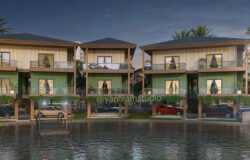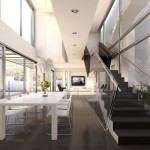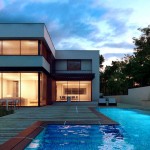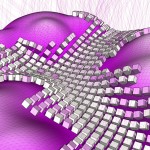Making of Japanese Rain Showers
Best of Week 33/2016 Image winner, Joel Langeveld, takes us through the process of making his remarkable “Japanese Rainshowers” visual which he did on his spare time from doing yet more great work at 3D Studio Prins, where he works as a 3d artist. Nothing fishy about this salmon!
Introduction
Hi there, my name is Joel Langeveld. I am currently employed as a 3D artist at 3D Studio Prins in The Netherlands. Nose of the Salmon (www.noseofthesalmon.com) is the name of my portfolio website to share my personal stuff with the rest of the world. I am not that technical, so don’t expect fancy materials or complex render settings. I am leaning more towards the artistic side. I hope you will enjoy this read.
Inspiration
During the summer I found some spare time to do some new personal work. I felt like making something nice and the huge amount of rain during the Dutch summers also helped a bit.
Whenever I work on a personal project I also want to experiment with some new techniques. Because the time was limited (1 full day and 2 evenings) it should be a straightforward process. If not, it would have ended up on the dusty pile of the unfinished-but‐could‐be‐great‐if‐I-have‐the‐time projects like we all have our hard drive.
I started looking on the internet for some nice references. While googling for unbuilt architecture (for example student projects) I stumbled upon a really nice vector drawing of Alexander Daxböck. Since the architecture and the composition was too my taste I could focus on the atmosphere and the texturing.
In terms of atmosphere, I went for the it‐just‐stopped‐raining mood, probably influenced by the rainy weather conditions over here in Amsterdam.
The fact I really love these foggy atmospheres also helps a little. Fog makes images more poetic. There is this famous image of James Dean walking in the rain on Times Square. This is the mood I would like to achieve.
Although it is a fairly common technique I wanted to do some tests with painting the texture for the road. I never did it before. This situation gives me the opportunity to do some nice texture painting with puddles, skid marks, cracks, signage, and dirt.
I ended up with a 32k pixel road texture and had some fun painting stuff you can’t even see in the render.
Another goal was to a lot in 3D. Often I rely on my Photoshop skills to finish an image. This time, I want to try to do it the other way around.
3d Modeling
Although I start with a lot of ambition, most of the time I am getting bored modeling quite fast. Hence the fact I solve a lot in PS.
But, like I said, this time, everything should be 3D.
First I started with the left side of the image. I had to guess the measurements from the vector drawing. It is really basic polygon modeling. Nothing special over here. What makes these buildings nice are the realistic textures from textures.com.
I added some Chinese lamps on the awning to enhance the Asian feeling. By placing them randomly (and not vertical) I tried to get the feeling wind blowing through the Tokyo streets.
The tip of the day is to use the SketchUp warehouse models to your advantage. I know, 90% of the warehouse is garbage, even architects make better SketchUp models. But, at the back of the top shelf, behind that box full of 6 polygon cars, on top of the shelf with the trees mapped on a plane, there are some real gems inside that warehouse.
The traffic signs are straight from the warehouse. As is the street cafe. The elevated metro in the background… straight outta SketchUp. And you don’t think I would model all these background buildings, right?
Of course, the electricity poles with the wires on the foreground are hand modeled… sike! also Sketchup.
The red stuff in the image is Sketchup, everything else is modeled by myself.
The road is just a plane. All the details are within the texture I painted. The sidewalk consists of different (simple) objects treated with different textures.
I have added some water drops on the wires. I thought it would look cool and add some detail. The wires were remodeled with a renderable spline. I made one small sphere to represent a raindrop.
Now I was able to use the spacing tool to evenly spread the raindrops along the spline. To make it more random, I random selected 70% of the raindrops and deleted them. The leftovers were treated with an object randomizer, so they will differ in size and shapes.
Texture & Materials
The vector drawing barely had any information on the type of materials used. Deciding the materials was a purely intuitive process. I always had a soft spot for the Cincinnati art museum by Zaha Hadid. I love the black and white concrete. So I figured it could be cool on this building. It makes the building manly and stands strong in this kind of weather conditions.
Texturing was fairly basic. Since it rained I added sharper reflection on the materials and more than normally would have been the case. For the raindrops on the window, I used a black and white texture inside the bump slot. At first, I wanted to scatter raindrops on the windows. But then I stumbled upon this method on the web on giancr.com. I doubted it would work, but at the first test, I already noticed that this will work out fine and fast.
Another new thing for me was texturing the road with one big map. I modeled the outline for the road, rendered the unwrapped mapping and brought it into Photoshop.
The first thing to do is to test how big this texture should be. So I tiled some regular asphalt texture and rendered the image at 4500px (height). After some tests I came to the conclusion the Photoshop file should be 32k pixels, to get this road texture sharp enough in a render. (Which was quite a pain in the ass for my slow ass laptop).
Now I could start painting on the right resolution. Although it was not quite necessary for this scene, I had fun painting all the details on the road. The skid marks to the garage and on the crossing, the gutter alongside the road, the arrows and road signs (too bad I didn’t paint nice road signs with Japanese characters), the sewers, the cracks, the different types of asphalt.
The post‐production made a lot of these details vanish, but I can really see the benefit of doing it like this all the time. You have way more control over the quality and level of detail of the road.
Lighting
To achieve this just‐after‐rain mood I needed a nice cloudy sky to light up the scene. Eventually, I went for the 1044 overcast HDRi from Peter Guthrie.
The HDRi has a medium-bright sun in it. This sun generates some nice soft shadows. It gives the idea that the rain just stopped and the sky opens up and the umbrellas can be closed again. I reduced the gamma to 0.9 to boost the contrast of the HDRi, and thus the amount of light and shadows.
All the interior lights are done with a simple V-Ray light. I have set the interior lights to disc type and put the directional to 0.78. In this case, the VRayLights will behave like a cone shaped spotlights.
Rendering
Not interesting at all 🙂
I have used the good old LC‐IM combo.
Post Production (read as Main Production)
Now it is time to bring this piece to life. Get some story in it and make it attractive.
The way this tutorial is set up it may seem like the post‐production part is the final part of making an image, as the naming also suggests. But I like to fire up Photoshop as soon as I can. So after the first crappy renders, I already start playing around in PS to see if it is all worth it. I would even say that the majority of the Photoshopping is already done before tweaking the materials and the modeling. So the term post‐production is not really applicable in my workflow ;‐)
The first thing I do in PS is start playing with the elements. Basically, I use 8 elements, next to the masking elements (see image below). I use them in screen mode or in linear dodge mode to enhance some parts of the scene.
After I put the elements on top of the raw render I do some rough Contrast and Color Balance. As you can see there is a lot of fog in the scene. The base is setup with the Z‐depth element (in screen mode and a level adjustment layer), after that, I painted a shitload of fog on top. I just used the standard brush and a simple cloud brush as one can find on the internet. Just make sure you keep the depth in the scene by masking out the objects in front of the fog.
The vignetting is also an important part to me. I like a heavy vignetting so that the spectator will get drawn into the image.
As I told in the beginning, the famous James Dean image was an important reference. Not only the mood but also his body language, his facial expression are key. So my James Dean is the girl with the umbrella, let’s name her Marilyn. The position of the umbrella was perfect for my it‐just‐stoppedraining mood. She draws a lot of attention and composition‐wise she is a great counterpart for the building. Marilyn is also quite classy dressed and apparently heading for Block 7. As an ode to the James Dean image, I also put him in the image.
To complete this part, I made a breakdown video of the post production
































Who else thinks #blog is cool
Am really in love with the boldness of your work would love to learn more
Am a student Architect by the way
Hard Work, nice 3d Modeling..
Why We Are Better?? https://writers.essayunion.com/
Really love those road textures and effects, could you tell me which software did you use to make road texture like yours?